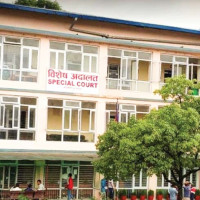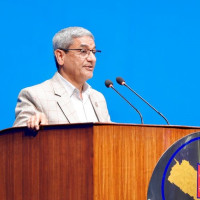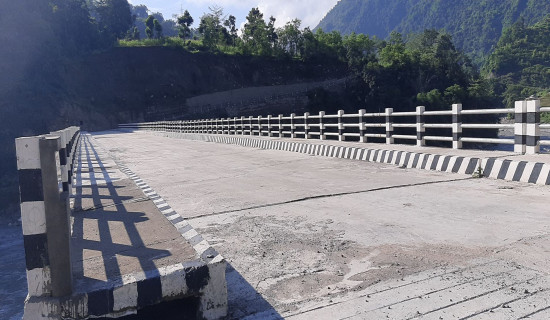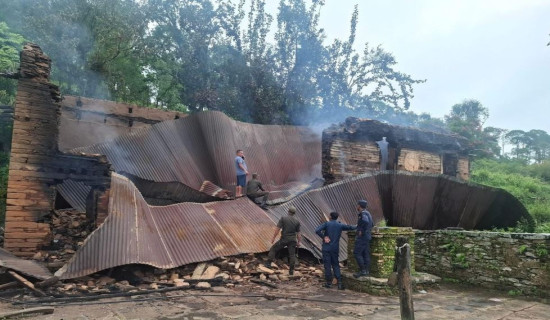- Thursday, 10 July 2025
Translate Republican Spirit Into People’s Life
As the clock was ticking at midnight on April 15, 2008, the Constituent Assembly of Nepal erupted in roars. The first meeting of the Constituent Assembly abolished Nepal’s 240-year-old monarchical system. This was, therefore, a historic and momentous day in the history of modern Nepal.
Later in 2015, the Constituent Assembly came up with a democratic and republican constitution, thereby formally institutionalising a federal democratic republic. Nepal’s first president, Dr. Ram Baran Yadav, promulgated the first ever constitution written by the democratically elected representatives of Nepal. Members of the Constituent Assembly stood with applause, marking the ultimate victory of the people. Despite many hitches and some hiccups in the constitution-making process that the Constituent Assembly faced for over six years, the process was finally complete, delivering a genuinely democratic and republican constitution.
The bottom line of the third Jana Andolan and a decade-long Maoist people’s war was the abolition of the monarchical system and establishing republican democracy. This long-cherished goal of the Nepali people was finally achieved and institutionalised through the 2015 constitution.
Monarchy is a feudal institution that believes in and promotes hereditary and dynastic systems. The monarchy is an anti-democratic institution that is not compatible with the basic norms and principles of democracy. Monarchy is a dynastic rule under which a dynasty and a clan rule without political competition and without accountability. In a genuine democracy, dynastic rule is not permitted. In monarchies, members of the royal family are above the law. Democracy is the rule of law in which all citizens, irrespective of position and power, are equal in the eyes of the law. The Republican system alone guarantees genuine and full democracy, as an ordinary citizen, too, can be the head of the state. This is not possible in the monarchical system, as certain people hold positions of power soon after their birth. Thus, the declaration of the republic was a fateful and historic day.
Nepal remained under different forms of monarchy, during which monarchy was portrayed as an institution rooted in the history and culture of Nepal. However, monarchy always played a negative role and undermined democracy in Nepal. Monarchy remained the symbol of feudalism and dictatorship. Dictatorship can never be the culture of any country or society. Moreover, the republican system has ensured a situation in which even an ordinary citizen can reach the highest position, namely the head of the state. In monarchies, only a certain clan member reserves the right to be the head of the state.
Thus, the claims and clamours of royalists and supporters of monarchy proved to be farce and futile because the abolition of monarchy took place so easily and smoothly that people across all walks of life, soon after the decision, came out in the streets and celebrated with fireworks and jubilation, welcoming the declaration of the republican system. The declaration of Nepal as a republican country, in a real sense, turned Nepalese people from subjects to citizens. It was thus a great triumph of people through which they ascertained their supremacy in political decision-making, thereby making the people masters of their destiny in real sense. The principal credit for this goes to the people of Nepal for their courage and valour, as well as the political parties, including the Maoist Party, that fought a decade-long insurgency pursuing the agenda of republican Nepal.
Much blood was shed by the people of Nepal to achieve this goal. In the decade-long Maoist insurgency alone, thousands of people sacrificed their lives for the cause of republican democracy. The sacrifice of the people did not go in vain ultimately, as Nepal was declared a republican democracy.
The republican agenda was first raised by the communist party in 1949, when the Communist Party of Nepal was formed. The manifesto of the Communist Party of Nepal very clearly raised this issue, clearly demanding the abolition of monarchy and the establishment of a republic. Communists are more vocal on Republican issues than other parties. However, in the third Jana Andolan, the Nepali Congress, too, stood for a republican agenda. If the Nepali Congress had not stood in favour of the abolition of monarchy, it may not have been possible to establish a republican system. The Nepali Congress, right from the beginning, had been pursuing the twin-pillar policy (parliamentary democracy and constitutional monarchy). But monarchies always conspired against democracy and tried to impose monarchical dictatorship. King Mahendra died in 1961, and King Gyanendra followed in his father’s footprints in 2003. Eventually, the Nepali Congress too reached the conclusion that, as long as monarchy remains, democracy may not take root. Thus, the Nepali Congress, too, stood against monarchy, which made the establishment of the republican system easier. Thus, the Nepali Congress, too, deserves commendation.
In a way, the role of monarchy, too, was responsible for the abolition of this institution. Nepal’s political equation has always been triangular. Nepal has three political forces: rightist, centrist, and leftist. The monarchy divided the centrist and leftist groups and accordingly ruled. After the 1990 political change, the rightist section was weakened. But the monarchy survived as the centrist Nepali Congress and leftist communists were divided. In the third Jana Andolan of 2005, the centrist Nepali Congress and leftist parties, namely the CPN-UML and CPN-Maoist, joined hands against the monarchy. Thus, the monarchy was so easily overthrown and abolished.
In its long political trajectory, Nepal has experimented with different systems and regimes. Now we have arrived at the present republican stage, which is the era of people's power. Republican Nepal is definitely better than monarchical Nepal. However, much still needs to be accomplished to fully consolidate this system. Democracy is good governance and effective delivery of service. This has to be reflected in the functioning of the government and the conduct of political parties. Positive change has to be seen in the lives of people. This will alone make the Republic Day celebration more meaningful.
(Lamsal is a former editor-in-chief of TRN and former ambassador.)
















